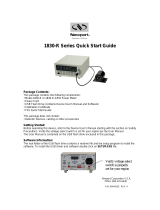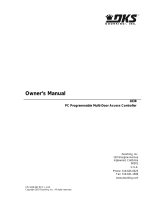
4
1800-065 Issued 1-19
Version G
Powering Up System - The Voice/Data cellular system will NOT function until online registration has been successfully completed on DoorKing’s Cellular website.
Within 1 minute of powering up the cellular module, the lights should turn on. If they don’t, check that the ON/OFF button is turned ON. Signal strength Bars should
be lit GREEN indicating good cell reception. YELLOW bars indicates poor reception but may still work. RED bars indicates no reception. The cellular module’s lithium
battery needs time to charge. Allow at least ½ hour of charging time before using system.
Using Two 1830 Entry Systems - Each 1830 must be programmed for MULTIPLE SYSTEMS. see specific 1830 Installation/Owner’s instruction manual for informa-
tion to program each 1830.
TWO 1830 Entry Systems Master Codes -Each 1830 entry system’s Master Code must be DIFFERENT. The DKS cellular server identifies each 1830 by its unique
master code. This allows separate programming for each 1830.
Voice/Data Cellular System Master Code -
IMPORTANT: Program the Voice/Data cellular system master code the SAME as System A’s master code.
See Programming for instructions on how to set the cellular system master code on page 5.
The DKS cellular server may need to contact the Voice/Data cellular system and uses System A’s master code to do so.
RS 232 Baud Rate for Older 1830s - The Voice/Data cellular system and the 1830 entry system(s) MUST have matching RS 232 baud rates (bps). Newer 1830s and
the Voice/Data cellular system default to 19,200bps but older 1830s may be running at ONLY 9600bps. It is preferred re-programming older 1830s to 19,200bps. If
the older 1830s cannot be re-programmed up to 19,200bps, then the Voice/Data cellular system can be re-programmed down to 9600bps to match the older 1830s.
Contact tech support for instructions on how to re-program the cellular system down to 9600bps.
Remote Program Testing - Install DoorKing Remote Management Software version 6.3.g or later on an internet connected PC that will be used for
1830 programming and management. Create an account and open the system Info screen. Enter System A’s master code, phone number that has been
assigned, and pick DKS Cellular for the service type. If a second 1830 is connected, create a second account with the same settings as above except System
B’s master code MUST be different. Refer to the Remote account manager software manual for additional settings which MUST be made.
Enter some test data into the resident screen and then attempt to send the data to the 1830.
DKS Cellular requires a SEPARATE registration from the DKS IM Server. If a customer already has an IM Server account and wants to add a DKS Cellular system, this
will require a SEPARATE User ID and Registration.
• DKS IM Server includes: IM Server Modem and IM Server Client.
• DKS Cellular includes: Cellular Phone and Data Transfer.
Before registering a cellular system on DoorKing’s Cellular Server you will need:
• SIM ID number located on the cellular module (number is unique for each cellular module).
• Master Code of System A.
• Master Code of System B if connected, MUST be a different master code than System A.
OPTION 1. Go to DKS cellular website: https://dksdb.dksoftware.com/NewUserRegChoice.aspx to register, follow instructions on website.
OPTION 2. Online registration is directly offered when installing the DoorKing Remote Management Software version 6.3.g or later on YOUR internet connected PC.
Create an account and select whether the account will manage:
• Voice and Data (entry systems 1833,1834,1835,1837, or 1838 with voice)
• Data Only (1838 with no voice)
• Voice Only (limits available features that can be used on all 1830 entry systems and is not recommended for the 1830s)
Enter the SIM ID number to identify the Cellular System to the account created. After the SIM ID number is entered along with the local billing address,
a local cellular phone number will be assigned to that cellular device.
Register the 1830 systems (Master Codes) to the account. The FIRST 1830 master code entered will be identified as System A. If a second 1830 master code
is entered, it will be identified as System B.
Online Registration MUST be Completed
Voice/Data Cellular System Needed Information
Testing
Final Testing after the Cellular System has been Registered - All systems should be tested and final
adjustments done. Connect a telephone butt set to the cellular system circuit board Phone Line and make sure the line is
active and that phone calls may be made and received.
If the phone line is not active, something went wrong during the registration which must be corrected. If still having
problems, call DoorKing tech support. Attach a label to the inside of the cellular enclosure listing the local phone number
that was assigned during registration. For DATA ONLY cellular systems skip the voice testing and proceed to remote
program testing.
1816
PH LINE
SYSTEM A
RJ11
PHONE
JACK
PH LINE
DATA OUT
RS 232
BUSY OUT
BUSY IN
GROUND
DATA IN
OR
Set program slide
switch to NORMAL
for dial tone.
Voice Testing - On the 1830 circuit board lower left corner is a jumper for phone line matching. Remove the jumper from the UPPER position and
place it on the LOWER position labeled 1816. This allows the 1830 speakerphone OPTIMUM performance when using cellular and MUST be done.
Program a phone number into the memory of the 1830 using the 1830 keypad. Then call that programmed number on the 1830. Have the call
recipient press “9” on their phone to open the door. Verify the 9 tone is detected (door will open). Adjust the feedback on 1830 as necessary. This
adjustment is VERY important for DTMF detection. See specific 1830 Installation/Owner’s instruction manual for programming and adjustment
information.
IMPORTANT Note: Factory set Tone Open numbers: “9” TONE activates Relay 1. “0” TONE activates Relay 0. “5” TONE activates Relay 2.
For cellular, change the tone open number for Relay 2 to “8” TONE. Leave Relay 1 and Relay 0 tone open numbers the same.









